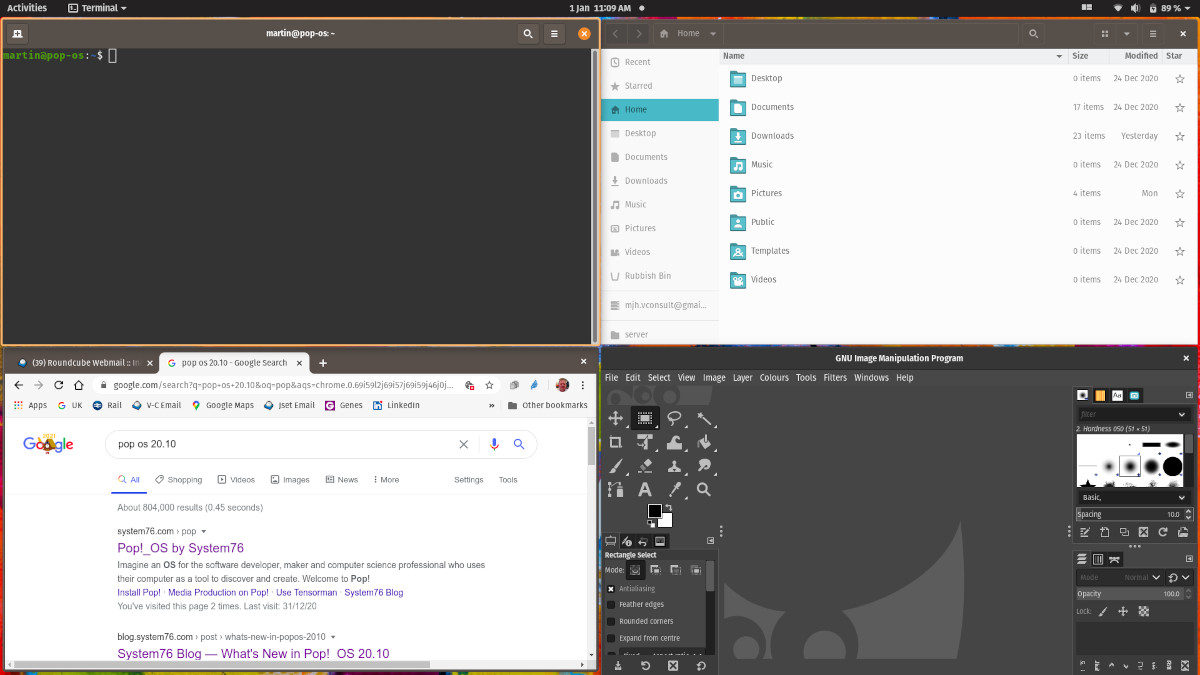Pop!_OS 20.10 Review

Update November 2021 - now running cutting edge Pop!_OS 21.10 with the 5.15 kernel on laptop
Over the last few days I've installed Pop!_OS 20.10 on my Laptop and Desktop, in each case replacing different flavours of Ubuntu previously installed. Here are some notes on my experience and the reasons for making the switch.
Pop!_OS is an Ubuntu-based Linux distribution created and maintained by Linux computer maker System76. It uses a customised version of GNOME Shell desktop. Pop!_OS 20.10 inherits all of the core foundational features found in regular Ubuntu 20.10, including a GNOME 3.38 base and the Linux 5.8 kernel.
My laptop is a trusty Lenovo ThinkPad T440p with an i7 CPU, 8GB of RAM and a recently upgraded 1080p screen. It was previously running Ubuntu Mate 20.10 but I was tempted to try Pop!_OS having read good reviews and having had a few issues with Snap confinement on Ubuntu preventing access to the server on which we keep all our data. The install from a USB flash drive was straightforward, taking only a few minutes, and I was soon up and running installing my favourite software packages, including GIMP. Significantly, GIMP installed using Flatpak from Flathub and suffered none of the issues of confinement experienced with the snap on Ubuntu. I'm really surprised that Canonical don't offer the option of classic confinement on software such as their GIMP and Inkscape Snaps where the typical user will have either a separate server or different partition on which they keep their data.
As an aside, I recently got grief from my wife who was unable to download a file from the Internet on her desktop machine, this recently upgraded to Ubuntu 20.10. On investigation the culprit was Chromium, installed as a Snap in this newest release, refusing her to follow my link to the 'correct' folder location on our server - a confinement issue again. I don't understand why the Ubuntu Team are not providing an option when installing Snaps to over-ride the confinement. My credibility has now been partially restored by installing Google Chrome (from Google) to replace the Chromium Snap.
The next install was on 'Titan', a 'self build' Intel i5 workstation/server with 16GB of RAM, last upgraded a few years ago that is 'always on' with low power consumption. This was also a breeze as I had purchased a new 500GB NVME drive for the OS that would fit into the free M2 slot on the Asus Z170 motherboard. This meant that the previous Kubuntu install on a SATA SSD need not be overwritten and could still be booted if necessary. Data on a 3TB HDD was also unaffected by the install and several partitions on this drive were subsequently remounted. Some preparation copying configuration data from files such as /etc/fstab /etc/export /etc/samba/smb.conf and the excellent Ubuntu guides helped both with mounting of HDD partitions and setting up NFS and Samba for serving files to other devices.
The Pop OS feature that allows automatic tiling of windows really came into its own on the 30 inch 4k Dell monitor that I have connected to this computer, bringing order where previously I would have had far too many windows open scattered all over the screen, many hidden. On the laptop, the benefit of this had been limited with windows becoming too small, but on this larger high resolution monitor I really like way it works. I've not yet got to grips with all the keyboard shortcuts and these will no doubt improve the use case on both desktop and laptop.
Software installs can either be on the command line or through the Pop!_Shop installer. On the installer some are available as Flatpak (from Flathub), whilst others install as Ubuntu (.deb) and this seems to work well either way.
The only customization I've done so far, apart from choosing the light theme that I prefer, is installing the Gnome Extension 'Dash to Dock' which has an intelligent auto-hide for the dock, which I really like.
So well done System76 and here's to a brighter 2021.